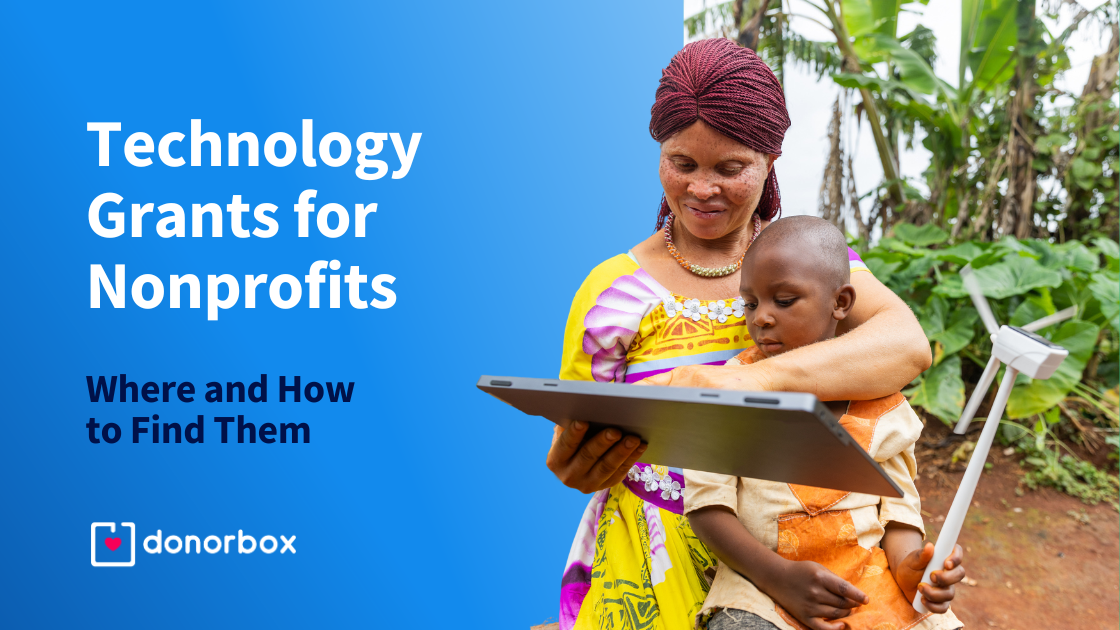Grants are one of the primary income sources for nonprofits. Many nonprofits apply for grants to fund their operational budget or nonprofit programs, but did you know there are technology grants for nonprofits?
Technology grants can fund the development of new technology and refine existing technology. Technology grants also provide nonprofits with access to fundraising or communication software to help them achieve their mission. These grants can help bring your nonprofit into the 21st century and increase donations to your organization.
The cost has always been a deterrent to purchasing the best technology to do the job. With technology grants, your organization can compete in the quickly growing world of online fundraising and marketing. This article can help get you started.
1. What is a Technology Grant?
Some technology grants are meant to help developers with the creation of new technology. This is especially true if the technology will help create a better world. Other technology grants are there to help organizations in education or medical facilities update their existing technology.

For the rest of the nonprofits, the most beneficial technology grants are the ones that make fundraising software more affordable and attainable. Are you a smaller organization that does not think you can afford an online donation system? Or, do you worry that you are falling behind other organizations doing the same work? Technology grants may be the answer to catching up.
2. How can Nonprofits Benefit from Technology Grants?
School districts and hospitals can significantly benefit from technology grants. In many rural areas or school districts with less funding, technology grants can provide access to education tools like handheld computer pads for their students. These tools can give students who do not have computers at home the chance to catch up to their peers.
During the pandemic, limited access to technology was one of the main reasons some students got lost in the system. More technology grants addressing this problem can eliminate that issue in the future.
As online fundraising becomes more popular with donors, not having a working online donation system can cost nonprofits thousands of dollars. Technology grants can help nonprofits in the following ways:
- Provides access to marketing and communication tools
- Allows nonprofits to monitor the campaigns’ successes
- Automates much of the process that can take up time
- Helps to manage donor and donation information
- Provides a secure way to collect funds online
- Enables nonprofits to access costly online processing systems
These tools help smaller nonprofits reach a larger audience, and also benefit from new online fundraising tools and practices.
3. Main Sources of Technology Grants for Nonprofit Organizations
Nonprofits have historically sent out grant applications for operational budgets or specific programs. As technology advances, nonprofits have realized the importance of online fundraising and marketing tools and are searching for ways to afford them. The same also goes for schools and medical systems in search of technology for students, patients, and administration.
If you have ever applied for grants in the past, you may have noticed a better response rate if you ask for specific needs. Governments, foundations, and corporations would rather fund specific programs or requests from nonprofits than operational costs.

The same also goes for technology grants. If you ask for a specific technological tool and provide a way this tool can help you achieve your mission, your organization will have a better chance of accepting your grant proposal.
3.1. Government
Federal, state, and local governments offer nonprofit grants. Whether you are looking for operational costs, program funding, or technology grants for your organization, you may be able to find them with these sources.
3.2. Foundations
This is most likely where you are used to finding funding. Foundations can include well-known organizations like the Bill and Melinda Gates Foundation down to your local community foundation.
Depending on your need, this may be your best option for grant funding. The primary benefit of these grants is the help they can offer. Local nonprofit grant foundations also often give training on how to apply for grants and allow you to speak with funders face to face.
Most of these grants are not for large amounts, but if your organization is searching for ways to improve the technology in your office, these grants may be able to meet the bill.
3.3. Corporations
Corporations are also an excellent source of grant funding. Larger companies like Walmart, Google, and Amazon each have their own technology grant options. Tech companies have also realized the need for their supplies and services and have jumped into offering technology grants to nonprofits.
4. 10 Popular Technology Grants for Nonprofits
Corporate philanthropy is not new in the United States. Individuals like John Rockefeller and Andrew Carnegie regularly gave to charities and built libraries and museums for the public to help their image.
Companies and business titans of today are realizing again that giving to charity can improve their corporate image and improve relations with customers. One of the ways companies are doing this is with the 1% Pledge. This pledge is a commitment by businesses to give one percent of their company’s equity, time, product, or profit to nonprofits.
Social media and other advances in technology have opened people’s eyes to what companies do with their income. Consumers are using this information to make purchasing decisions, and companies have noticed. The 1% Pledge movement is a response to this reaction and a way to show that these companies care.
The following companies have all signed the 1% Pledge. Let’s look at the top ten companies providing technology grants for nonprofits.
4.1. Google

Google’s brand is valued at $299 billion and continues to be the third-largest tech giant in the world. Since the brand image is so essential at the top, Google has taken the 1% pledge and provides several technology grants and other funding options for nonprofits.
Benefits: Google has created Impact Challenges to address specific problems. There are impact challenges currently running across the world. These grants can provide up to 2 million dollars to the nonprofits who win them.
How to apply: Impact challenges go live on a rolling basis. When the challenge is live, any organization can submit its proposal. Community leaders and the public then choose which proposals will have the biggest impact. Visit the website to see which challenges are live and accept proposal submissions.
Google has also funded AI projects for social impact since 2018. Low-cost air sensors, pest control, and satellite monitoring have all helped grant recipients meet their goals in a third of the time, at half the cost. Visit the website to see which challenges are live and accept proposal submissions.
4.2. Google for Nonprofits

Google is the place to find information on just about anything. Those companies that can afford to purchase ad space are miles ahead of anyone else in getting themselves known. Google Ads, YouTube, and Google Maps are all helpful marketing tools businesses have benefitted from. In the past, the cost to use many of these features was so expensive that it did not seem feasible for most.
Benefits: Google has now created a program to help nonprofits. They are providing grants for $10,000 worth of in-kind text ads every month. YouTube has new features that can help nonprofits tell their stories to the right audiences. Google Earth and Maps also help show your organization’s impact maps that show donors their impact and give 360 tours of your locations. These features allow nonprofits to reach more donors and engage with the public and each other.
How to apply: Start by requesting a Google for Nonprofits account, and you can activate many of the products above.
4.3. Twilio

Twilio is an SMS and messaging platform that can help connect nonprofits with donors and volunteers worldwide. Users can either create their program or use an expert from their network to build voice, video, or email programs.
Benefits: Twilio has created an Impact Access program to provide a $100 kickstart credit, which is worth thousands of text messages and voice calls to connect with your donor base. How to apply: Eligible 501c3 organizations, B corps, or social enterprises can sign up for a Twilio account and apply for the kickstart credit or impact fund.
How to apply: 501(c)(3) organizations, B corps, or social enterprises can sign up for a Twilio account and apply for the kickstart credit or impact fund.
4.4. Box

Security is a big issue for nonprofits. Donors do not want to give to organizations that cannot protect their information. Box offers extra security for sensitive files and tools to share files with your co-workers, donors, and volunteers.
Benefits: Box has created a program for nonprofits to use these tools at affordable prices. They have also encouraged their employees to donate their time and expertise to volunteer with nonprofits. Grants are now awarded to nonprofits through Box.org
How to apply: Box has partnered with TechSoup to offer this option. You will need a TechSoup membership before applying for a donated or discounted Box subscription. Learn more about how to get started here.
4.5. Mozilla Foundation

Mozilla started with the Firefox online browser which many people prefer because of its speed and performance. The success of their browser and desire to give back inspired the company to create the Mozilla Foundation. It now funds educators, artists, and tech professionals who are working to create a better internet.
Benefits: Mozilla focuses on connectivity and open internet for all. They have funded projects that provide technology to universities, track disinformation spread on the internet, and provide internet to groups of people usually unconnected.
How to apply: Fellowships are awarded to people with new ideas on how to improve the internet for all, Mozilla awards give funds and a platform for their work.
4.6. Salesforce

Salesforce is the largest customer relationship management (CRM) platform in the world. With this solution, companies can connect with their customers, create better marketing messages, and improve their customer relationships.
Benefits: The Salesforce Foundation strives to help young people reach their full potential. Through grants and volunteer hours, they have provided education and work opportunities to thousands of students and young adults.
How to apply: Grant applications are by invitation only. To learn more about the organization and other ways your organization can benefit from the Salesforce Foundation, visit their website.
4.7. Lyft

Ride-sharing started with Uber, but Lyft quickly became a fierce competitor. Lyft pledged to give $50 million or 1% of its profits through its Lyft Up Initiative to make sure everyone has access to affordable, reliable transportation to get where they need to go
Benefits: As part of its goal to give back, Lyft provides free rides to job seekers, including interviews, training, and the first three weeks of new employment. Other LyftUp programs provide free rides for people living in food deserts, voters, and help for those recovering from natural disasters. Another initiative, in partnership with LeBron James’s company, adds more bike share access to lower-income neighborhoods. Lyft has partnered with several nonprofits to offer these initiatives to individuals.
How to apply: Riders can donate through the Lyft app. To apply for one of Lyft’s community grants, your organization must be a 501(c)(3) organization working to advance racial justice and make these communities stronger.
4.8. TechSoup

TechSoup was founded in 1987 as CompuMentor and was created to provide nonprofits and schools with technological tools. This organization has partnered with several organizations to provide technical support to nonprofits.
Benefits: Thanks to TechSoup, nonprofits can afford expensive technology to help them with fundraising and administrative needs. Organizations can purchase software, and hardware, and get help to manage both.
How to apply: Find your country and sign up for a membership here.
4.9. Microsoft

Microsoft is another industry leader that took the pledge. As the largest vendor of computer software worldwide, and a leading provider of cloud computing services, video games, computers, and hardware, Microsoft strives to help people and businesses reach their full potential.
Benefits: Nonprofits can apply for free technology grants and custom-built solutions for Azure, Dynamics 365, and Microsoft 365 programs. These tools help nonprofits improve the security of donors’ information, reduce costs, and empower staff and volunteers to work from anywhere.
How to apply: Microsoft gives Azure grants of $2,000 credits per year, and discounts on other features to nonprofits. Visit their website to check your eligibility and apply for these grants.
4.10. Facebook for Nonprofits

Facebook is known for connecting millions of people. They have decided to use those connections and made it easier for nonprofits to connect with donors and raise money online.
Benefits: Millions of nonprofits are using Facebook directly and collecting Facebook donations through Network for Good. Thanks to Facebook, marketing your nonprofit has never been easier. With Donate Buttons, Fundraise Stickers, and Fundraising pages and videos, nonprofits can find greater success with online fundraising.
How to apply: Sign up for your own Facebook page and gain access to these marketing and fundraising tools.
5. How to Find the Right Technology Grant for your Nonprofit (3 Best Practices)
Now that you have an idea of where to find these technology grants, we have a few tips to help you stand out in the crowd.

5.1. Focus on your mission
Your organization’s mission is the primary reason you exist. It is also the best way to raise funds. By sharing your mission with donors and the public, your nonprofit effectively spread the word about your nonprofit. When looking for grant funds, your mission will point you in the right direction to find foundations that connect with your end goals.
If your organization does not have a clear mission, be sure to correct this oversight. Learn more about mission statements and how to write an effective one for your organization.
5.2. Leverage grant databases
There are several grant databases that nonprofits can use to find grants. Grantwatch, Guidestar, and GrantStation are a few of these databases that make grant research easier. Input search profiles that fit your organization, location, and mission to find the ones that fit.
5.3. Do your research
Grants can be found with federal, state, and local governments, foundations, and corporations. By using your personal connections, your nonprofit will find the right grants for your mission. Once you know where to look, make sure you are speaking to the right person, eligible for the grant, and can meet the requirements and deadlines.
Connect
Finding the right person to connect with at the foundation or company will increase your organization’s chances of winning the grant. When possible, nonprofits can use their donors and volunteer contacts to find a personal connection within these organizations. These personal connections will help direct you. Once you have found the right person, be sure to stay in contact between grant openings. Learn more about ways to communicate with grantmakers here.
Check Your Eligibility
All grants have eligibility requirements for organizations that best fit their goals. By researching these requirements and following the rules, funders will know you care enough to pay attention.
Meet the Deadlines
If you miss the deadline to apply for a grant, you lose the chance to raise this money for your organization. Like the eligibility requirements, staying aware of the grant deadlines is essential to your success.
Final Thoughts
As technology advances, so do the opportunities for nonprofits. Governments and foundations continue to find ways to help. Businesses have pledged to use their power and money to give back to their communities. Some give through grants, and others by offering discounted prices for nonprofits.
Donorbox has joined with other organizations to supply affordable options for nonprofits. We offer no contract and affordable online donation processing, donor database, and online marketing tools.
Check out our features page to see how we can help your nonprofit. If you are looking for more information on finding grants or other online fundraising tips, visit our blog.

















